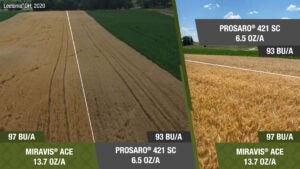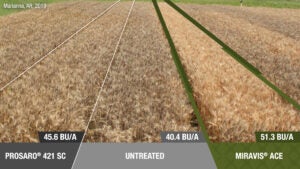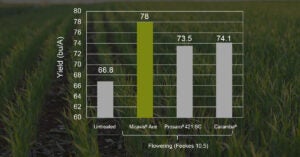ADEPIDYN technology in Miravis Ace fungicide combines premium head scab control in wheat with systemic plant-health benefits.
In recent decades, American growers have lost billions upon billions of dollars’ worth of wheat yields because of Fusarium head blight, commonly known as head scab. The devastating disease creates issues with both yield and quality. Affected kernels in the wheat head become discolored and fail to develop properly and mature, while environmental conditions can cause the Fusarium to produce mycotoxins that could be detrimental to the health of livestock and people.
Head blight is a greater problem today than it was 20 years ago, and without growers adopting innovative controls, Fusarium threats to wheat crops will continue to worsen.
A staple of control has been the triazole fungicide, a demethylation inhibitor (DMI) Group 3 compound that would halt the colonization of Fusarium in the kernel. However, to achieve that, this class of fungicides is limited to the three- or four-day window during which wheat is flowering — a daunting challenge for growers working across thousands of acres.
“Triazole fungicides have to be applied at flowering because they’re mostly curative, and you’d want to get the pathogen while it’s actively trying to infect so that you can stop that active infection,” said Tyler Harp, Syngenta Technical Product Lead for Row Crop Fungicides. “Now, Miravis® Ace contains a triazole, which will do that as well. However, it also contains the ADEPIDYN® technology, which has good preventive activity and a wealth of plant-health benefits.”
On the market since 2018, Miravis Ace, which uses ADEPIDYN technology mixed with propiconazole, is one of the few solutions commercially available for head blight that’s not fully dependent on triazole chemistry. It brings with it a forward-facing mode of action in this space: the high-performing carboxamide succinate dehydrogenase inhibitor (SDHI) — a unique segment within the Group 7 fungicide chemistry.

While a carboxamide SDHI is not new in agriculture, it is new against Fusarium head blight and delivers commercial-level control of the disease while offering up vital Syngenta plant-health benefits.
Conditions for Fusarium to thrive
Fungal pathogens tend to thrive in wet weather. Both 2018 and 2021 were among the wettest seasons the U.S. has recently experienced. Those years had many growers on edge, thanks to the increased risks from Fusarium in wheat and tar spot in corn.
Then an abnormally dry year like 2023 rolls around, and growers find themselves weighing whether to spend money by applying a fungicide. Yet, beyond Miravis Ace’s standout disease prevention and curative properties, its ADEPIDYN technology also promotes improved green leaf area and management of light energy, water, and nutrients in wheat plants.
So, it’s applicable no matter the conditions of the current season.
“You don’t know when it’s going to be a bad year, so you really need to make the application even before that’s confirmed,” said Harp, who has been working at Syngenta since 1999. “Our data clearly shows that when Miravis Ace is applied as part of sound agronomic practices and not as a situational decision — such as, ‘Is there going to be disease? Is it going to be wet or dry?’ — 80 percent of the time you’ll see a profitable return on your investment. And about a third of those are hit-it-out-of-the-park, really big returns on investment.”
As little as two or three days of light to moderate rainfall can favor infection in wheat, with optimal temperatures being between 75 and 85 degrees (though high humidity can lead to lower temperatures also being highly conducive).
The perfect storm for head blight would be those wet conditions coupled with a lack of crop rotation. The pathogen survives in wheat stubble and can also be found in corn. So, by not rotating in soybeans or canola, the pathogen can build up in the soil, particularly when coming upon a couple of cooler rainy seasons.

In many environmental circumstances, the Fusarium mold also produces a mycotoxin called deoxynivalenol (DON), otherwise known as vomitoxin.
DON levels can be high even when disease levels are low, and batches of wheat can be docked if DON levels are above one part per million (levels as high as four parts per million can be salvaged if blended with healthier kernels).
Generally speaking, a poorly managed field can make Fusarium almost overwhelmingly difficult to control.
“Miravis Ace worked well. We had ideal conditions for head scab, and the fungicide did its job,” said Loren Bock, a grower from Belfield, North Dakota. “We had the best wheat yields we have ever had.”
When yield matters
Wheat is most susceptible to pathogens at early flowering when the anthers form. It’s why growers long relied heavily on older triazole fungicides, which targeted that narrow 10.51 to 10.52 stage on the Feekes scale and were most successful if they were able to cover the entire wheat head with the product.
The application window for Miravis Ace, on the other hand, is much broader on the Feekes scale. The ADEPIDYN technology is labeled to be applied from 10.3, when the head is halfway emerged from the boot, to 10.52, when the head is fully emerged and in full flower.
“That’s because of the mode of action,” Harp explained. “We have a more preventive and more persistent mode of action that will continue to give you protection for a longer period of time.”
Miravis Ace eases some of the application pressure of having to be in the right place at the right time during flowering.
Despite the opportunities that this extended timeframe allows, Syngenta still recommends that growers try to hit that flowering timing as much as possible, because the data shows that optimal plant health and the best yields are connected to significant DON reduction and efficacy.

Trial data has also consistently shown that using Miravis Ace leads to an 11.6 bu/A1 yield increase over untreated wheat, and Harp said that it amounts to a five to six bu/A increase over competing fungicidal products.
He also noted that intensive testing was done by a contract research organization in Kentucky that focuses on wheat. Harp said that the feedback he was given from that firm boiled down to: “Every treatment that contained ADEPIDYN was better than every treatment that didn’t contain ADEPIDYN.”
Seeing the stark difference with Miravis Ace is why Syngenta experts advise growers to include an untreated strip in the field. Growers can make comparisons between healthy wheat plants and those with the bleached spikelets and lightweight, discolored kernels that Fusarium head blight causes.
“Miravis Ace ran to the top of the food chain for head scab control,” said Austin Nyhof, a retailer in Bowbells, North Dakota. “With the consistent control, the consistent positive yield increase, and the grain quality increase we’ve seen with it, it’s getting to the point where Miravis Ace is almost unmatched.”
This article was published on behalf of Syngenta. Visit this page to find a Syngenta Crop Protection Specialist near you.
Ryan Tipps is the founder and managing editor of AGDAILY. He has covered farming since 2011, and his writing has been honored by state- and national-level agricultural organizations.



